A Very Unusual Scandinavian Wooden Tankard, by John Johnson
I collect a large variety of steins and tankards. You could call my collection eclectic, as I have steins of many different types and from many different manufacturers. I became excited when I came across the following wooden tankard
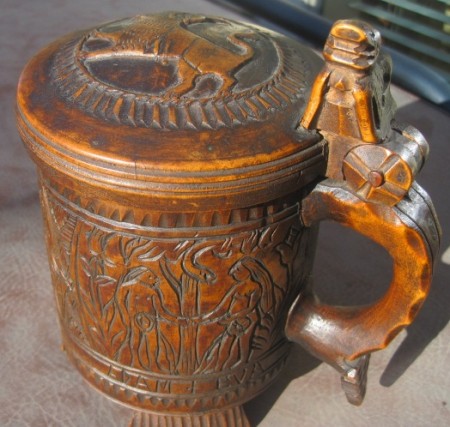
on a UK antiques dealer’s website. The dealer claimed it had been recently displayed in a US Midwest museum which had decommissioned the exhibit where it had been displayed.
.
The tankard has the appearance of a typical late 1700’s/early 1800’s Norwegian tankard with a Norwegian folk art interpretation of the Country’s coat of arms (the royal lion) carved into its lid. I would estimate that it would have a capacity of about 1/2 liter and dimensionally is approximately 6 inches tall from carved feet to top of lid.
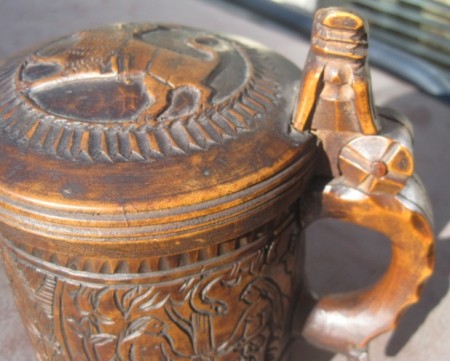
Note the nicely carved animal (a lion holding a small globe ball) *** thumb-lift which is about 1 1/2 inches tall. It has a three-piece hinge with rosette design around hinge pin. The handle is carved and the tankard sits on three carved feet typical of tankards of Norwegian origin of this period.
.
The design on the lid is about 4 inches in diameter with carved scroll work around perimeter of the lion design.
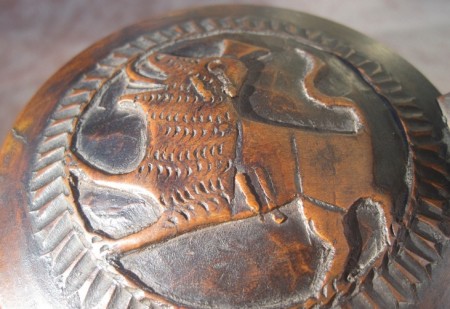
.
The tankard has its handle attached by two carved wooden pegs ▼, and has very thin wall thickness and was obviously turned in construction.
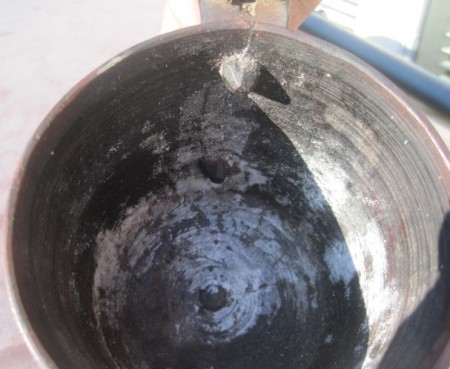
The tankard’s bottom is shown just below ▼. The sticker and numbers on bottom are likely inventory notations from when the tankard was on museum display.
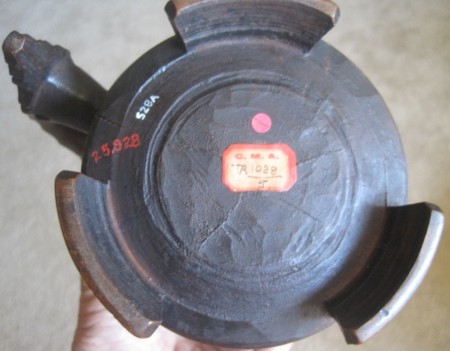
.
Note the nicely carved handle and end finial of the tankard below.▼. Also please review the construction and linear carving on the tankard feet.
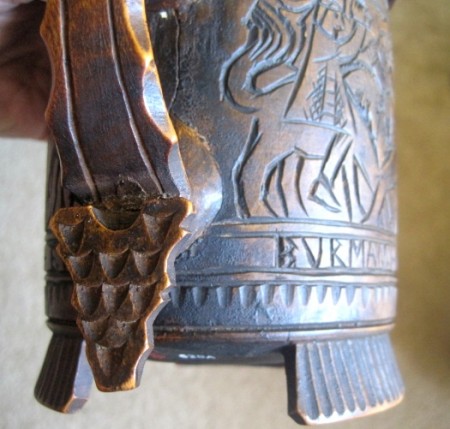
.
What I believe makes this tankard unique are the three carved images on the circumference!
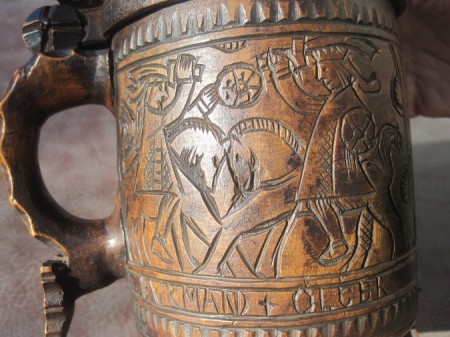
One of the most interesting scenes shows two medieval dressed warriors on horseback engaging in battle. One of the figures wears a crown and has a shield. The caption underneath the scene reads “Burman and Olger”. “Holger the Dane” is a mythical figure with special significance as a national hero of Denmark. He is said to be sleeping in some secluded spot, waiting for the time when he will be needed once more, to defend his homeland. [Editor’s note: For a similar legend, see: Barbarossa, Kaiser Frederick, (“The Red Beard Emperor Frederick”) in this site’s Compendium.]
In the 1500’s the name of “Holger” was modified to “Olger” by writer Christiern Pedersen. From Nordic sources, he is first seen in the latter half of the 13th Century. The figure of Holger/Olger the Dane has been expanded in song and ballads over the past Centuries. Interestingly, a Copenhagen-based World War 2 resistance group named for Holger/Olger was formed with the purpose of sabotage against the German occupation and collaborators in the spring of 1943. Although many members of the group were arrested, and 64 members died in action, Holger Danske continued to operate (after several reconstructions), throughout the remainder of the war.
Below one will find a historic poem/ballad with the history to “Olger the Dane and Burman,” translated from Danish folklore in the early 1800’s that tells of a great battle and victory by Olger the Dane:
“OLGER THE DANE AND BURMAN” [Editor’s note: Two lines are placed together into one to save space / and easier reading, hopefully.]
Burman in the mountain holds, Makes his shield shine brightly there;
A message he sends to Iceland’s King, For he has a daughter fair.
“Hear, good King of Iceland, hear, Hear what now I say to thee:
Give to me thy daughter fair, And divide thy land with me.
“Either yield thy daughter fair, And divide with me thy land,
Or the warrior good prepare Who in fight can me withstand.
I have daughter none but one, Damsel Gloriant her they call;
To King Carvel she’s betrothed, And in him my trust is all.
“I have given her to a King And King Carvel hight is he;
If he fail to defend the maid, Then thy booty she shall be.”
Twas the King of Iceland good, To his daughter’s bower he goes;
And the Damsel Gloriant To receive him gently rose.
“Hear, all dearest daughter mine, For I bring thee tidings new;
Burman in the mountain holds, He would win thee and doth woo.
“Burman is a kempion dour, And of jesting nought he knows;
He will surely have thee soon, If no warrior him oppose.”
It was Damsel Gloriant, Silent would no longer stand:
“In our tower a prisoner is Who will Burman take in hand.”
It was Damsel Gloriant, Her blue mantle o’er her threw;
Swiftly to the prison tower, Where the prisoners lay she flew.
It was Damsel Gloriant, ’Bove the prisoners all she cried: “
Hear thou, Olger good, the Dane, Have thy legs yet power to stride?
“Art thou living, Olger Dane? I have something to impart;
There is a trold for me that lusts, And that trold is Burman swart.
“I’ll not wed the filthy guest, I’m betrothed to Christian knight;
I to thee will subject be If thou conquer him in fight.”
“Here I’ve lain for fifteen years, All in chains and bondage hard;
Blessings on thee, Gloriant, That to me thou hast repaired.
“Here for fifteen years I’ve lain, Borne fierce hunger-pangs, and thirst;
I’m not able now to wage Fight as I was able erst.”
“Hear thou me, good Olger Dane, Save me from my peril, save;
Ere I take the ugly trold I would fling me in my grave.
“Burman is fierce, his horse is wild I to thee will tell forsooth,
I have heard and been assured That he bites with wolfish tooth.
“Nothing, nothing will he eat But the flesh of Christian men;
And nothing, nothing, will he drink But human blood mixt up with bane.”
“Thy father means a gallant man, King Carvel to share thy bed;
Can he not hold thee from the trold, That thou unto me hast sped?
“Blessings on thee, Gloriant, That thou didst upon me think,
With Burman I will break a lance If thou give me good meat and drink.
“Canst thou procure my horse again, My good sword and hauberk tried?
Then for thy sake it will be, I a course with him will ride.
“Carvel is my stall-brother true, To his ears ’twill doubtless come;
Rather would I lose my life Than the fiend should bear thee home.”
“The best food which thou shalt choose I for thee will straight provide;
And I will give thee thy steed again, Which thou lovest best to ride.
“I will give thee the strongest sword E’er that armed a warrior’s side;
Give thee too a faulchion hard, Well thereon thou may’st confide.”
Olger from the tower they took, Garments for him have they wrought;
They sat him highest at the board, And rich meats for him they brought.
Burman riding came to court, Thought to bear the maid away;
Olger the Dane against him rode, And soon found him rougher play.
For two days they stoutly fought, As the third towards evening drew
Down upon a stone they sat, They their strength would there renew.
Then the valiant Burman kemp, To the Danish Olger said:
“Quarter I will grant, if thou Wilt believe in Mahommed.”
Little could brook that, Olger the Dane, On his foe fierce looks he bent:
“When thou dwell in blackest hell Say by Olger thou wast sent.”
Up then leapt the kempions twain, ‘Gainst each other rode anew;
Then asunder went their helms, And afar their faulchions flew.
They fought so long, they fought so hard, That their strength was well-nigh flown;
Slain at length was Burman Kemp, Dead to earth fell Burman down.
Olger to the Damsel rode “Thou mayst take thy plighted knight,
For I have with my good sword Slain the foul and poisonous sprite!”
[This version of the original poem was taken from a translation from the Old Danish, by English author George Borrow, 1803-1881.]
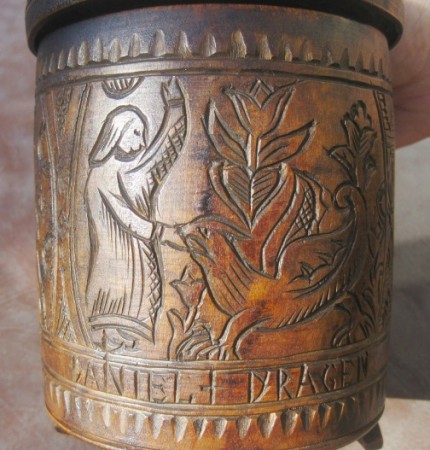
The second scene on the Scandinavian tankard shows “Daniel and Dragen (Dragon in both Danish and Norwegian)”. This references the religious story of Daniel in the Lion’s Den. The reference of Daniel and the Dragon is found in the extended Book Of Daniel which exists only in Greek in the Septuagint. It is referred to as deuterocanonical in that it is not universally accepted among Christians as belonging to the canonical works accepted as the Bible. In this companion narrative of the dragon, “there was a great Dragon, which they of Babylon worshiped.” In this case the supposed god is no idol, but an animal. However, Daniel slays the dragon by baking pitch, fat, and hair to make barley-cakes that the dragon eats to cause the dragon to burst open upon consumption.
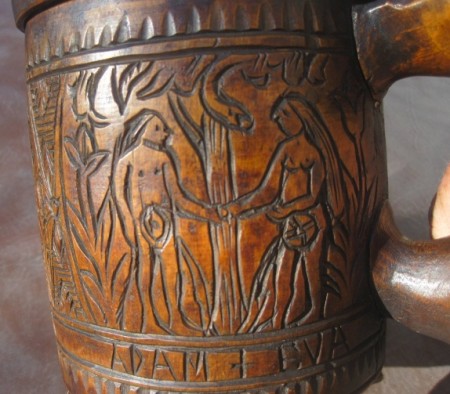
The third scene on the Scandinavian tankard depicts Adam and “Eva” with snake/serpent in the Garden of Eden. Although somewhat “crudely” carved (with lack of fine detail), I find this scene and others nicely portrayed. Note the spelling of Eva for Eve.
I find the mix of Norwegian and Danish design influences on the tankard very interesting. I also find the mix of religious and secular content of the artwork fascinating. Denmark and Norway united into one dominion in 1524. In 1536, the Norwegian kingdom was formally dissolved and integrated into Denmark. Norway was reestablished as a kingdom in 1660. The personal union of the two kingdoms lasted until 1814. Based on this history, there would be a close relationship of culture between these two countries and its people. It is interesting to speculate as to the mix of art reflected on this tankard from the Danish folklore tale of Olger the Dane to the Norwegian coat of arms on lid and typical Norwegian construction of tankard. I suggest several possible scenarios below:
• The tankard was originally constructed in Norway as Norwegian coat of arms and lion thumb-lift are typical of other wooden tankards constructed in the late 1700’s/early 1800’s in Norway and transported to Denmark where it was locally carved at later date reflecting local/regional folk lore and religious belief.
• The tankard was constructed in Norway and carved locally there for possible sale in Denmark.
• A Norwegian wood craftsman emigrated to Denmark and constructed the stein and carved the stein there to reflect local history.
• Perhaps a Dane traveled to Norway and had a wooden tankard “of the period” custom carved to be brought back home for display purposes. I doubt this tankard was a utilitarian item as the carving on tankard would be costly to just use tankard as a “drinking mug”.
• Perhaps in the days this tankard was constructed, there were trade associations between large population centers in Norway and Denmark where Norwegian constructed tankards were sent for local “embellishment “and sold into local markets.
• Un-carved Norwegian tankards of this design are not uncommon. For such a small populated country at the time, one wonders why so many tankards of this nature can still be found. Perhaps many of these tankards might have been made for export/sale in other locales. Denmark is a neighboring country to Norway. Danish carving on the tankard would enhance its sales appeal to local residents.
However this tankard came into existence, I have never personally seen a mix of Danish and Norwegian influences before on a wooden tankard. The tankard design and art scenes make this tankard a very special piece in my collection.
[END]
5-9-2013, Editor’s notes:
[1] A fine addition to “SteveonSteins!!”
Many thanks to John for writing this for us all to enjoy!
[2] This stein /tankard is of a “pegged construction,” that is to say the handle was “pegged” to the body and the thumblift was carved separately and “pegged” into the top of the handle. Those features do not qualify it to be called a “Peg” Or a “Pin” Tankard.
[3] To read more about “Peg” / “Pin” tankards please see: http://www.steveonsteins.com/wooden-steins-1
[4] *** For a brief discussion about this “lion and globe/ ball” thumblift, see the first question on:
http://www.steveonsteins.com/unaswered-questions-about-beer-stein-and-drinking-vessels-draft
Steve(onsteins)
[END – SOK – 9 – .5 R5 ]
WISH TO CONTACT ME? STEVE (STEPHEN) =
 I wish more people had some common sense, so I wouldn’t have to bitch so much!
I wish more people had some common sense, so I wouldn’t have to bitch so much!

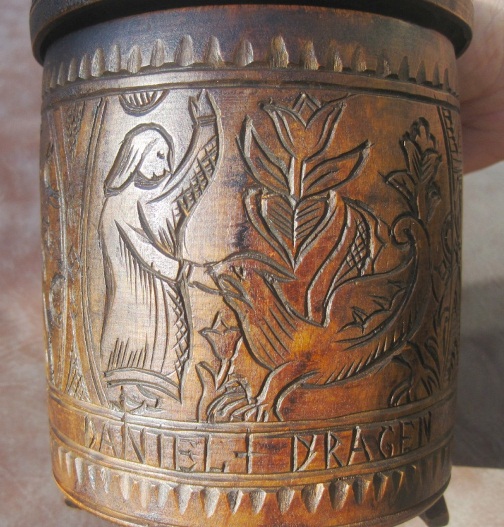
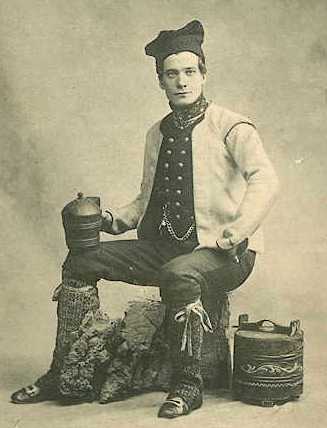
Leave a Reply